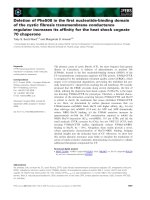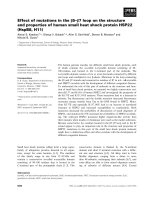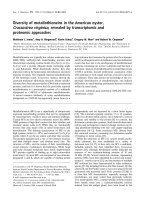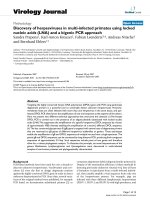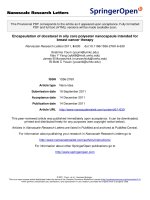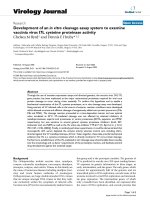Báo cáo sinh học: " Estimation of heritability in the base population when only records from later generations are available" doc
Bạn đang xem bản rút gọn của tài liệu. Xem và tải ngay bản đầy đủ của tài liệu tại đây (506.45 KB, 9 trang )
Estimation
of
heritability
in
the
base
population
when
only
records
from
later
generations
are
available
L
Gomez-Raya
LR
Schaeffer
EB
Burnside
University
of
Guelph,
Centre
for
Genetic
Improvement
of
Livestock
Animal
and
Poultry
Science ,
Guelph,
Ontario,
Canada
NI G
2W1
(Received
8
November
1990;
accepted
28
November
1991)
Summary -
The
genetic
variance
and
heritability
of
a
quantitative
trait
decrease
under
directional
selection
due
to
the
generation
of
linkage
(gametic
phase)
disequilibrium.
After
a
few
cycles
of
directional
selection
in
a
population
of
infinite
sire
a
steady-state
equilibrium
is
approached.
At
this
point
there
is
no
further
reduction
in
these
parameters
since
the
disequilibrium
generated
by
selection
is
offset
by
free
recombination.
In
many
situations
records
available
to
estimate
genetic
parameters
come
from
populations
at
the
steady-state
equilibrium.
A
simple
method
to
obtain
estimates
of
genetic
variance
and
heritability
in
the
base
population
using
estimates
of
these
parameters
at
the
equilibrium
is
described.
The
method
makes
use
of
knowledge
of the
effect
of
repeated
cycles
of
selection
on
genetic
variance
and
heritability
to
infer
the
base
population
parameters.
genetic
variance
/
heritability
/
estimation
of
genetic
parameters
/
linkage
disequi-
librium
Résumé -
Estimation
de
l’héritabilité
dans
la
population
initiale
en
utilisant
seule-
ment
les
données
des
générations
subséquentes.
Lorsqu’il
y
a sélection
directionnelle
sur
un
caractère
quantitatif,
la
variance
génétique
et
l’héritabilité
sont
réduites
à
la
suite
de
la
formation
d’un
déséquilibre
de
liaison
(phase
gamétique).
Après
quelques
cycles
de
sélection
directionnelle
dans
une
population
de
taille
infinie,
un
équilibre
stable
est
at-
teint.
À
partir
de
ce
moment,
il
n’y
a
plus
aucune
réduction
de
ces
paramètres
puisque
le
déséquilibre
créé
par
la
sélection
est
compensé
par
la
recombinaison.
Dans
plusieurs
situations,
les
données
disponibles
pour
estimer
les
paramètres
génétiques
proviennent
de
populations
en
équilibre
stable.
Une
méthode
simple
d’estimation
de
la
variance
génétique
et
de
l’héritabilité
dans
la
population
initiale
est
présentée.
Cette
méthode
tient
compte
de
l’effet
d’une
succession
de
cycles
de
sélection
sur
la
variance
génétique
et
l’héritabilité
pour
inférer
la
valeur
de
ces
paramètres
dans
la
population
initiale.
variance
génétique
/
héritabilité
/
estimation
des
paramètres
génétiques
/
déséquilibre
de
liaison
Original
article
INTRODUCTION
The
estimation
of
genetic
variances
and
heritabilities
of
quantitative
traits
in
populations
under
artificial
or
natural
selection
is
a
common
objective
in
animal
breeding
and
evolutionary
biology
of
natural
populations.
Standard
methods
to
estimate
genetic
variances
and
heritabilities
when
information
is
available
on
the
parents
and
offspring
are
the
correlation
among
sib
and
the
regression
of
offspring
on
parents
(Falconer,
1989).
Analysis
of
variance
of
half-sib
yields
biased
estimates
of
heritability
if
the
parents
are
a
selected
sample
from
the
population
(Robertson,
1977;
Ponzoni
and
James,
1978).
Unbiased
estimates
of
heritability
by
half-sib
correlation
can
be
obtained
after
correcting
for
the
bias
induced
by
selection
of
sires
(Gomez-Raya
et
al,
1991).
Regression
of
offspring
on
parents
is
not
altered
by
selection
of
animals
to
be
parents
(Pearson,
1903)
and
therefore
estimates
of
heritability
by
regression
are
unbiased
(Robertson,
1977).
In
both,
half-sib
and
regression
analyses,
unbiased
estimates
of
heritability
are
obtained
after
one
cycle
of
selection.
Regression
estimates
of
heritability
are
not
unbiased
for
the
accumulated
reduction
in
genetic
variance
after
repeated
cycles
of
selection
(Fimland,
1979).
The
changes
in
genetic
variance
under
selection
were
described
by
Lush
(1945)
using
genetical
arguments
and
a
numerical
example.
Bulmer
(1971)
formally
established
the
theory
to
explain
the
changes
in
the
genetic
variance
under
continued
cycles
selection.
Under
the
assumption
of
an
infinitesimal
gene
effect
model
the
genetic
variance
and
heritability
are
reduced
due
to
the
build-up
of
linkage
(gametic
phase)
disequilibrium
in
a
population
of
infinite
size
and
with
discrete
generations.
After
only
a
few
cycles
of
directional
or
stabilizing
selection
a
limiting
or
steady-
state
equilibrium
value
for
these
parameters
is
approached.
At
this
point
the
new
disequilibrium
generated
by
the
selection
of
parents
is
offset
by
free
recombination.
Most
animal
populations
are
probably
in
the
steady-state
or
close
to
it
since
the
equilibrium
is
approached
very
quickly.
The
use
of
standard
methods
to
estimate
genetic
variance
and
heritability
yields
estimates
of
these
parameters
in
the
limit
situation.
However,
in
many
cases,
interest
is
on
the
parameters
in
the
non-
selected
base
population.
Sorensen
and
Kennedy
(1984)
have
shown
that
mixed
model
methodology
may
be
used
to
estimate
the
genetic
variance
and
heritability
in
the
base
population.
They
carried
out
a
simulation
experiment
for
several
cycles
of
mass
selection
and
then
proceeded
to
estimate
genetic
variances
using
a
minimum
variance
quadratic
unbiased
estimator
(MIVQUE)
under
the
correct
model.
They
found
close
agreement
between
observed
and
simulated
parameters.
The
requirement
of
using
the
correct
model
implies
making
use
of
the
relationship
matrix
with
complete
pedigree
information
back
to
the
base
population.
Natural
populations
are
currently
under
selection
and
pedigree
information
is
not
known.
In
livestock
species,
such
as
dairy
cattle,
pedigree
information
is
only
recorded
from
the
later
years.
In
general,
mixed model
methodology
requires
the
genetic
variance
of
the
base
generation
as
determined
by
the
available
data
and
corresponding
pedigree
information.
Therefore,
if
the
available
data
and
pedigrees
are
only
for
animals
at
the
point
of
selection
equilibrium,
then
the
genetic
variance
at
selection
equilibrium
is
needed
to
evaluate
animals
by
mixed model
methods.
However,
knowledge
of
genetic
variance
in
the
base
population
(prior
to
starting
selection)
is
necessary
to
predict
response
to
alternative
breeding
programmes
in
which
selection
intensity
and/or
accuracy
of
evaluation
differ
from
those
in
the
current
breeding
programme.
Any
changes
in
those
parameters
alter
the
amount
of
disequilibrium
maintained
in
the
population.
After
a
few
cycles
of
selection
a
new
equilibrium
will
be
approached
which
can
be
predicted
with
knowledge
of
new
selection
intensity,
new
accuracy
of
evaluation,
and
the
genetic
variance
in
the
base
population.
The
objective
of
this
paper
is
to
describe
a
method
to
estimate
base
population
genetic
variance
and
heritability
from
data
available
at
the
steady-state
equilibrium.
Use
is
made
of
effect
of
repeated
cycles
of
selection
on
genetic
variance
and
heritability.
Assuming
the
population
is
at
the
equilibrium,
the
base
population
parameters
are
obtained
by
reversing
Bulmer’s
arguments.
THEORY
Consider
an
additive
infinitesimal
gene
effect
model.
The
trait
under
selection
is
determined
by
a
very
large
number
of
loci
with
recombination
rates
of
1/2.
Assume
that
selection
intensity
is
constant
across
discrete
generations
and
that
each
individual
belonging
to
the
same
sex
is
evaluated
with
the
same
accuracy.
Population
size
is
infinite.
Selection
is
by
truncation.
Assume
that
there
are
no
departures
from
normality
after
selection
(Bulmer,
1980).
The
basic
theory
to
explain
the
changes
in
genetic
variance
in
populations
undergoing
selection
was
first
given
by
Bulmer
(1971).
The
breeding
value
of
an
individual
i in
a
given
generation
is:
where
a8
and
aD
are
the
breeding
values
of
the
sire
and
dam
respectively
and
ei
is
the
mendelian
sampling
effect
in
individual
i.
ei
is
distributed
normally
with
variance
((1/2)
0’ A
.
) 2
in
a
population
of
infinite
size
where
or2A
O
is
the
genetic
variance
in
the
base
population.
The
genetic
variance
in
the
selected
group
of
parents
is
reduced
by
kr
2
(Pearson,
1903),
where
r
is
the
accuracy
of
selection
and
k
=
(Ø(x)/p)((Ø(x)/p) - x)
for
selection
of
the
top
ranking
individuals
(directional
selection)
and
k
=
2x(Ø(x)/p)
for
selection
of
the
middle
ranking
individuals
(stabilizing
selection);
x
=
standard
normal
deviate;
§(x)
=
ordinate
at
cutoff
points
for
p
=
proportion
selected.
The
genetic
variance
in
the
offspring
can
be
partitioned
into
between
and
within
family
components.
The
within-family
variance
is
not
affected
by
selection
of
parents
and
has
value
((1/2)
QAo
).
This
is
true
on
the
assumptions
of
a
very
large
number
of
loci
and
infinite
population
size,
ie
no
change
in
the
gene
frequencies
of
the
segregating
loci
for
the
trait.
The
between-family
variance
has
a
value
of
(1-krLl)(1/2)0’!t-l’
where
QAt
_1
is
the
genotypic
variance
in
the
previous
generation.
Therefore,
the
genetic
variance
in
a
given
generation,
t,
assuming
different
selection
intensities
and
accuracy
of
selection
in
the
2
sexes
is:
where
r,,_,
=
accuracy
of
selection
of
sires
in
generation
t
-
1;
r
Dt-1
=
accuracy
of
selection
of
dams
in
generation
t —
1;
k9
and
kD
are
the
values
of
parameter
k
for
sires
and
dams,
respectively.
At
the
limit
there
are
no
further
changes
in
the
genetic
variance
since
the
new
disequilibrium
generated
in
that
generation
is
compensated
for
by
free
recombina-
tion.
Then,
genetic
variance
becomes:
After
some
algebraic
manipulation
this
reduces
to:
Assuming
constant
environmental
variance
across
generations
and
substituting
expression
[1]
in
the
standard
formula
of
heritability,
the
heritability
at
the
equilibrium
limit
is:
If
the
population
is
at
the
steady-state
equilibrium
and
records
are
available
to
estimate
genetic
variance,
then
estimates
of
base
population
parameters
can
be
found
by
solving
expressions
[1]
and
[2]
for
ar2A
and
ho,
respectively,
and
by
substituting
true
values
by
their
estimates.
Thus,
genetic
variance
and
heritability
in
the
base
population
can
be
obtained
by:
where
&dquo;&dquo;’&dquo;
denotes
estimate.
!
If
selection
criterion
is
the
individual
phenotype
then
ri&dquo;,
=
F2 D,
=
!2
and
expressions
[3]
and
[4]
reduce
to:
respectively.
In
these
expressions k
=
0.5k
8
+
0.5k
D.
The
required
estimates
of
the
genetic
variance
and
heritability
at
equilibrium
can
be
obtained
by
either
regression
or
maximum
likelihood
methods.
It
is
generally
accepted
that
maximum
likelihood
estimates
of
genetic
variances
are
unbiased
by
selection
of
parents
if
all
the
pedigree
information
is
included
in
the
analysis.
If
REML
(restricted
maximum
likelihood)
account
for
selection,
say,
in
generations
0
to
6,
then
it
will
also
account
for
selection
in
generations
6
to
10
when
only
data
from
these
generations
are
available.
In
the
former
case,
the
component
of
variance
estimates
the
genetic
variance
in
the
base
population,
and
in
the
latter
the
genetic
variance
in
generation
6
which
it
is
assumed
to
be
the
equilibrium
genetic
variance.
The
approximate
sampling
variance
of
the
estimate
of
heritability
in
the
base
population
can
be
obtained
by
differentiating
expression
[6]
with
respect
to
!2 L7
Therefore,
the
sampling
variance
of
the
estimate
of
heritability
in
the
base
population
depends
on
a
factor
f ,
which
is
a
function
of
h)
and
k
because
under
phenotypic
selection
h
depends
only
on
h)
and
k,
and
on
the
sampling
variance
of
h1.
Values
of
the
f
factor
for
different
£)
are
represented
in
figure
1
for
varying
selected
percentages
(p)
50%, 20%, 10%,
and
1%.
The
value
of
hi
was
obtained
by
solving
expression
[6]
as
a
function
of
known
h) :
as
described
by
Gomez-Raya
and
Burnside
(1990).
For
traits
with
heritability values
less
than
0.70,
f
is
larger
than
1
and
therefore
the
sampling
variance
of
!2
will
be
increased
with
respect
to
the
sampling
variance
of
the
estimates
at
the
limit
(Var
(hL)).
Selection
intensity
appears
to
have
small
effect
on
f.
In
practical
animal
breeding,
the
performance
of
relatives
can
be
used
to
max-
imize
response
by
the
use
of
selection
indices.
For
example,
consider
a
population
where
sires
are
selected
on
the
average
of
records
of
d
daughters
each
with
one
record
and
dams
are
selected
on
the
average
of
n
records
each.
Estimates
of
heritability
in
the
base
population
can
be
obtained
by
substituting
in
expression [4]
the
appropri-
ate
equilibrium
values
of
accuracy
for
sires
T
SL
= [dhLf(4+(d-l)hlW/2
and
dams
TvL
= [nhLf(l + (n-l)rêpL)]1/2,
where
rep
L
# [(8 fl! + 8 $! ) / (8 fl! + 8$! + 8$! )] ,
8$ !
= estimated
permanent
environmental
variance
and
QT
E
=
estimated
tempo-
rary
environmental
variance.
DISCUSSION
In
this
paper
a
method
to
estimate
heritability
in
the
base
population
from
data
at
the
steady-state
equilibrium
is
presented.
The
method
to
obtain
estimates
of
parameters
at
the
equilibrium
is
assumed
to
be
unbiased
by
selection
of
parents
in
that
particular
generation.
Estimates
of
heritability
by
regression
of
offspring
on
parents
is
unbiased
by
selection
in
a
given
generation
(Robertson,
1977).
Estimation
of
heritability
by
half-sib
correlation
is
biased
by
selection
of
sires
(Robertson,
1977;
Ponzoni
and
James,
1978),
but
estimates
can
be
corrected
(Gomez-Raya
et
al,
1991),
and
then
final
estimates
free
of
selection
bias
can
be
obtained.
Another
alternative
is
to
use
the
method
given
by
Sorensen
and
Kennedy
(1984).
They
proposed
the
estimation
of
genetic
variance
in
later
generations
using
the
MIVQUE
algorithm
and
assuming
that
individuals
in
the
generation
in
question
are
unrelated.
In
the
same
paper
they
carried
out
a
simulation
experiment
to
test
the
validity
of
this
method.
In
generation
7
actual
genetic
variance
had
decreased
from
10
to
8.41.
The
simulated
environmental
variance
was
10,
so
heritability
at
the
limit
was
0.457,
assuming
that
environmental
variance
was
known
without
error.
The
percentage
selected
in
males
was
50%
(k
s
=
0.637)
in
each
generation.
Dams
were
not
selected
(k
D
=
0).
Using
expression
[6]
after
substituting
estimated
with
true
parameter
values
and
corresponding
values
of
hi,
ks
and
kD
the
heritability
in
the
base
population
is
expected
to
be
0.491,
which
is
very
close
to
the
simulated
heritability
in
the
base
population
(0.50).
On
the
other
hand,
Van
der
Werf
(1990)
carried
out
2
different
simulation
experiments
in
which
mass
selection
was
practised
on
males
at
different
selection
intensities
corresponding
to
percentage
selected
p
=
10%
and
p
=
25%.
He
proceeded
to
estimate
components
of
variance
using
REML
(restricted
maximum
likelihood)
and
the
data
from
generations
4
and
5
with
pedigree
information
known
back
to
generation
3.
Treating
sires
as
random
in
the
model
he
obtained
biased
estimates
(8.58
for
p
=
10%
and
8.71
for
p
=
25%)
of
the
base
population
genetic
variance
(10).
If
we
assume
that
the
population
is
at
the
steady-state
equilibrium
in
generation
3
then
genetic
variance
in
the
base
population
can
be
estimated
using
[5]
after
substituting
appropriates
values
of
k(k
s
=
0.830
for
p
=
10%
and k,
=
0.759
for
p
=
25%;
kD
=
0)
and
!2
(0.45
for
p
=
10%
and
0.46
for
p
=
25%).
The
values
of
!2
can
be
obtained
from
the
estimates
of
genetic
(8.58
for
p
=
10%
and
8.71
for
p
=
25%)
and
residual
variances
(10.44
for
p
=
10%
and
10.17
for
p
=
25%)
given
by
Van
der
Werf
(1990)
in
table
II.
Proceeding
in
this
way,
estimates
of
the
genetic
variance
in
the
base
population
are
10.18
(p
=
10%)
and
10.23
(p
=
25%).
These
values
are
very
close
to
the
simulated
genetic
variance
in
the
base
population
(10).
The
slight
discrepancy,
in
these
studies,
occurs
because
the
formulae
derived
in
this
paper
have
not
taken
into
account
the
effect
of
inbreeding
in
the
reduction
of
genetic
variance.
Throughout
this
paper,
population
size
has
been
assumed
infinite,
and
therefore,
inbreeding
effects
on
genetic
variance
were
not
considered.
Both
natural
and
livestock
populations
are
finite.
The
reduction
in
genetic
variance
due
to
the
build-up
of
linkage
disequilibrium
occurs
rapidly
in
the
first
generations
whereas
inbreeding
effect
is
small
but
accumulates
gradually
in
later
generations.
After
the
steady-state
equilibrium
is
achieved,
the
genetic
variance
reduces
gradually
due
to
inbreeding
and
so
does
the
amount
of
linkage
disequilibrium
maintained
in
the
population.
Thus,
correction
for
selection
at
this
point
would
not
yield
estimates
of
the
genetic
variance
and
heritability
in
the
original
base
population.
Rather,
the
estimates
of
these
parameters
would
be
those
obtained
after
relaxing
selection
for
several
generations,
in
other
words,
the
genetic
variance
due
to
the
gene
frequencies
segregating
in
the
population
at
the
generation
in
question.
In
most
situations,
these
are
the
parameters
of
interest
because
they
explain
how
much
genetic
variability
could
be
used
in
selection
programmes.
Prediction
of
the
joint
effects
of
inbreeding
and
selection
on
genetic
variance
is
rather
difficult
(Robertson,
1961;
Verrier
et
al,
1990;
Wray
and
Thompson,
1990).
The
method
described
in
this
paper
is
able
to
correct
for
the
bias
generated
after
repeated
cycles
of
selection
assuming
equal
information
on
each
individual
evaluated
and
constant
selection
intensity
across
generations.
In
practice,
both
assumptions
may
not
hold.
Methods
to
estimate
breeding
values
such
as
best
linear
unbiased
predictor
(BLUP)
are
preferred
to
selection
index
in
the
improvement
of
livestock.
Each
individual
breeding
value
has
a
different
accuracy
in
BLUP
evaluations.
If
pedigree
information
is
known
back
to
the
base
population
then
mixed
model
methodology
could
be
used
(Sorensen
and
Kennedy,
1984).
The
effect
of
different
accuracies
among
selection
candidates
on
genetic
variance
is
not
known.
Further
work
is
needed
to
incorporate
this
kind
of
selection
in
the
method
presented
in
this
paper.
Changes
in
selection
intensity
across
generations
result
in
changes
in
the
disequilibrium
in
the
population
parameters
over
time.
In
natural
populations,
selection
intensity
could
oscillate
due
to
changes
in
the
pattern
of
interaction
among
species
and/or
environmental
fluctuations.
In
livestock
populations,
selection
intensity
may
fluctuate
due
to
changes
in
production
system
or
in
market
conditions.
Therefore,
the
procedure
described
in
this
paper
would
give
only
approximate
values
of
the
base
population
heritability.
However,
oscillation
in
the
selection
intensity
across
generations
has
small
effect
on
the
estimation
of
heritability
in
the
base
population
because
the
parameter
k
changes
only
very
slightly
with
selection
intensity.
For
example,
if
we
use
a
wrong
value
of
selection
intensity
corresponding
to
selection
of
the
top
1%
(k
9
=
0.903;
kD
=
0)
in
the
simulation
experiment
of
Sorensen
and
Kennedy
(1984),
then
heritability
in
the
base
population
after
using expression
[6]
is
0.504.
This
value
is
again
very
close
to
the
simulated
heritability
(0.50).
Therefore,
even
though
selection
intensity
is
not
constant
across
generations
the
method
described
in
this
paper
could
be
used
to
estimate,
in
a
very
approximate
manner,
the
value
of
heritability
in
the
base
population.
ACKNOWLEDGMENTS
We
gratefully
thank
C
Smith
and
B
Villanueva
for
very
useful
comments.
This
research
was
supported
by
Instituto
Nacional
de
Investigaciones
Agrarias
(Spain)
and
the
Ontario
Ministry
of
Agriculture
and
Food
(Canada).
REFERENCES
Bulmer
MG
(1971)
The
effect
of
selection
on
genetic
variability.
Am
Nat
105,
201-
211
’
Bulmer
MG
(1980)
The
Mathematical
Theory
of Quantitative
Genetics.
Clarendon
Press,
Oxford
Falconer
DS
(1989)
Introduction
to
Quantitative
Genetics.
Longman
Press,
Essex,
3rd edn
Fimland
E
(1979)
The
effect
of
selection
on
additive
genetic
parameters.
Z
Tierz
Zuchtungsbiol96,
120-134
Gomez-Raya
L,
Burnside
EB
(1990)
The
effect
of
repeated
cycles
of
selection
on
genetic
variance,
heritability,
and
response.
Theor
AppL
Genet
79,
568-574
Gomez-Raya
L,
Schaeffer
LR,
Burnside
EB
(1991)
Selection
of
sires
to
reduce
sampling
variance
in
the
estimates
of
heritability
by
half-sib
correlation.
Theor
Appl
Genet
81,624-628
Lush
JL
(1945)
Animal
Breeding
Plans.
The
Iowa
State
University
Press,
Ames,
IA,
3rd
edn
Pearson
K
(1903)
Mathematical
contributions
to
the
theory
of
evolution.
XI.
On
the
influence
of
natural
selection
on
the
variability
and
correlation
of
organs.
Phil
Trans R
Soc
Lond
Ser A
200,
1-66
Ponzoni
RW,
James
JW
(1978)
Possible
biases
in
heritability
estimates
from
intraclass
correlation.
Theor
Appl
Genet
53,
25-27
Robertson
A
(1961)
Inbreeding
in
artificial
selection
programmes.
Genet
Res
2,
189-194
Robertson
A
(1977)
The
effect
of
selection
on
the
estimation
of
genetic
parameters.
Z
Tierz
Zuchtungsbiol
94,
131-135
Sorensen
DA,
Kennedy
BW
(1984)
Estimation
of
genetic
variances
from
unselected
and
selected
populations.
J
Anim
Sci
59,
1213-1223
Van
der
Werf
JHJ
(1990)
Models
to
estimate
genetic
parameters
in
crossbred
dairy
cattle
populations
under
selection.
Doctoral
thesis,
Dept
Anim
Breeding,
Agric
Univ,
Wageningen,
The
Netherlands,
ch
5
Verrier
E,
Colleau
JJ,
Foulley
JL
(1990)
Predicting
cumulated
response
to
direc-
tional
selection
in
finite
panmictic
populations.
Theor
Appl
Genet
79,
833-840
Wray
NR,
Thompson
R
(1990)
Prediction
of
rates
of
inbreeding
in
selected
populations.
Genet
Res
55,
41-54

